From a Trail of Tears to A River of Sadness - History Tends to Repeat Itself - [history][today]
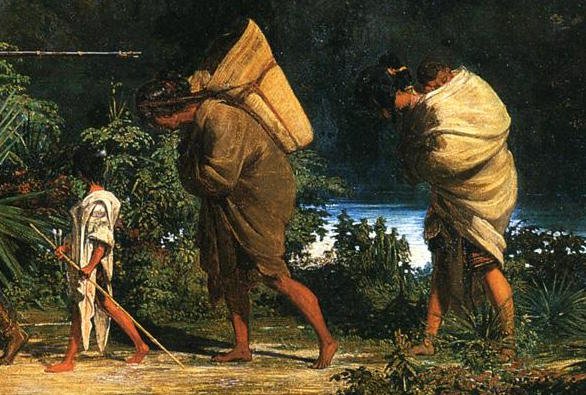
From a Trail of Tears to A River of Sadness
The 'Indian Problem'
Part I
The Lost Explorer Leads the Way
North America was first encountered by Leif Erikson and then by Erik the Red around the 11th and 12th centuries. It would be several hundreds years later, when a lost European named Christopher Columbus, under the Spanish flag, ran into the Caribbean Islands in October of 1492. Mistakenly thinking his ship had made it to Asia and the shores of India, he unwittingly called the local island natives "Indians."

Columbus watches his hunting dogs feed on Natives
Almost immediately upon finding this land, the Europeans began the exploitation of both the land and its native inhabitants. The hundreds if not thousands of different native tribes who lived in North America had done so for thousands of years prior to the arrival of Europeans, but none had experienced the voracious greed and fervor of religious capitalism. Columbus almost immediately captured and enslaved natives he met in order to learn the source of their golden jewelry. Columbus would even enslave young girls and women to be used for the pleasures of his men.
It would not be long before the rest of Europe would follow Columbus to the supposedly "new" world. Spain would continue its expansion into this part of the world, with Juan Ponce de Leon killing many of the native tribes of what is now Florida, USA and Hernan Cortez would vanquish the great Aztec Empire by 1521 in what is now Mexico. Portugal quickly followed Spain to this "new" land. Portugal claimed parts of North and South America, with both countries bringing death and destruction for the local natives of these lands.
.jpg)
The Spanish abusing the Amerindians
England lagged behind both Spain and Portugal mostly due to political and religious strife at the time. It would not be until Elizabeth I, daughter of Henry VIII, came into power that England truly began its imperialistic aspirations. At first, the British settled for allowing government sanctioned privateering/pirateering of Spanish ships coming with treasure from the new world. The British government received a portion while the pirates, like Sir Francis Drake, became wealthy. It came to a head with the British fleet defeating an attacking Spanish Armada of 130 ships in 1588. This great naval victory opened the seas to Great Britain's explorers, leading to the first permanent British North American Colony of Jamestown, Virginia in 1607.
The Second Wave
While the Spanish and Portuguese mainly focused on Mexico, Central and South America, other European nations began looking towards the north. With the Spanish and Portuguese fully occupied with their colonization of their parts of the world, it was now time for the Dutch, British, French, Russian and some smaller European nations to push their colonization efforts into full gear. The practice of conquering and indoctrinating by the Spanish and Portuguese was similarly practiced by these other nations.
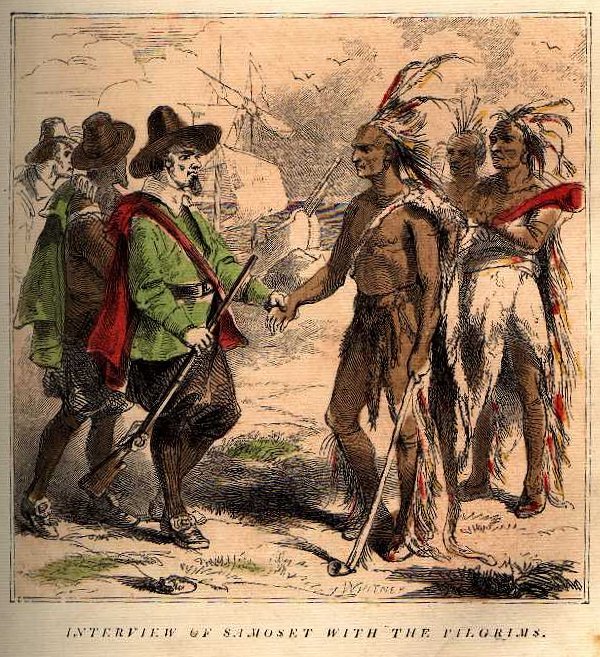
In 1620, the Pilgrims landed on Plymouth Rock, Massachusetts. Fleeing English religious persecution, the Pilgrims left England for Holland. While in Holland, they were eventually granted a charter to start a colony allowing them to spread their religious beliefs under England's authority. This was now the founding of the second British colony on North American soil called Massachusetts.
By now the natives realized that like the Spanish, the English and the rest of the Europeans were not as friendly as they at first appeared. In Virginia, the English needed more land to grow tobacco, encroaching on more and more Native American lands. The forests were cleared, the wild game was hunted and more English settlements were built. Throughout North America, the newly arrived Europeans encroached so much on Native American lands that between 1540 - 1774 there were at least twelve major war between the different colonizers and the Native American Indians. Some wars were between opposing colonist backed by opposing Native American tribes on each side. As the Native Americans ceded more and more land from this violent encroachment, the British colonies multiplied, numbering 13 with an estimated population of some 2 to 3 Million colonists by 1776.
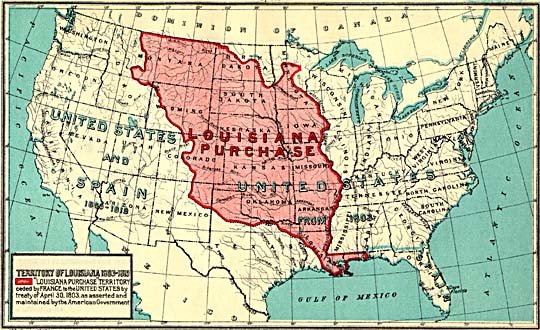
When the American Revolutionary War was officially declared over during the signing of the Treaty of Paris in 1783, it effectively doubled the United States in land size. The British gave up a large portion of their land holdings from the Allegheny Mountains west to the Mississippi River. The Spanish still controlled what today is Florida and large swaths of the American West, while France had the Louisiana Territory. France sold this land to the newly formed United States of America with the signing of the Louisiana Purchase Treaty in 1803. This added another 828,000 square miles of land to the United States.
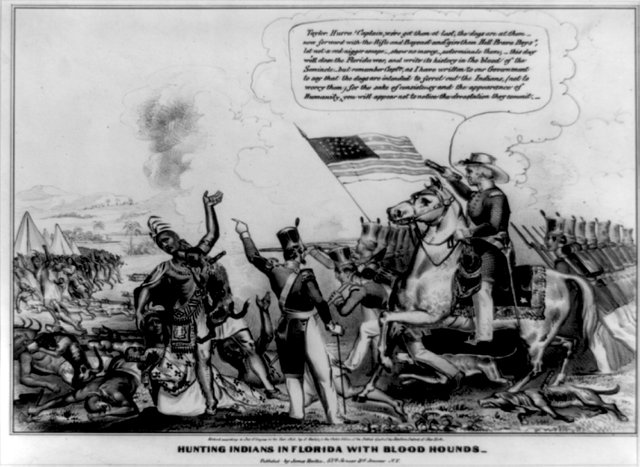
"Hunting Indians in Florida"
Between 1775 and 1842 there would be 15 more major wars between the ever expanding United States and the Native Americans. The Natives, having lived hundreds if not thousands of years upon their same ancestral lands defended their homes and many paid for it with their lives. In 1830, President Andrew Jackson signed the Indian Removal Act, granting (unsettled) lands west of the Mississippi to the natives located within boundaries of the United States in exchange for their tribal land, mostly in the Southeastern United States. Many tribes realized the futility of fighting while others refused to relocate, leading to warfare and other tragedies.
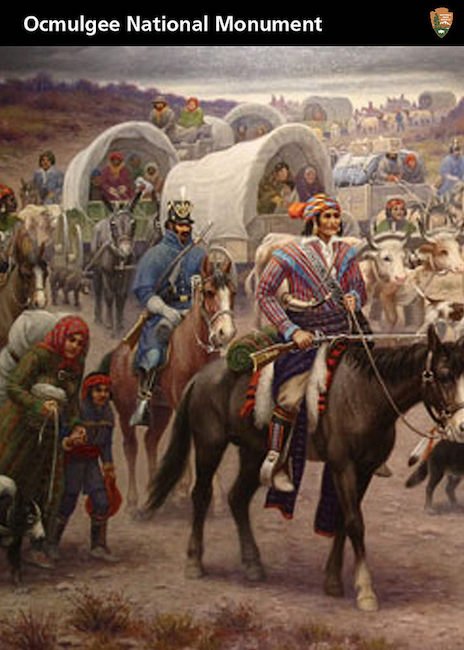
Forced Migration of the Creek Native American Tribe
In 1831, the Choctaw Native American tribe was the first to be relocated from the Southeastern United States to what then was the unsettled territory of Oklahoma. After much fighting, many of the Seminole Native Americans were forcibly made to follow the Choctaw in 1832. The Creek Native Americans were forced to move in 1834 followed by the Chickasaw tribe in 1837. In 1838, the Cherokee Native American tribe was the last to follow in what would later become known as the "Trail of Tears." Over 50,000 Native American were displaced from their ancestral homelands, many forced to walk hundreds of miles to their new destination. The U.S. Government had promised the Natives support and transportation but failed to deliver on many of its promises, leading to many deaths of Native Americans as they made the treacherous journey west.
Full Steem Ahead!
@streetstyle
sources:
http://wikipedia.org
http://www.ushistory.org/us/2.asp
https://www.history.com/topics/native-american-history/trail-of-tears
https://www.history.com/topics/pilgrims
http://www.encyclopediaofalabama.org/article/h-1433
https://www.pbs.org/wgbh/aia/part4/4p2959.html
https://www.loc.gov/rr/program/bib/ourdocs/indian.html
http://www.loc.gov/teachers/classroommaterials/presentationsandactivities/presentations/timeline/colonial/indians/marries.html
http://www.softschools.com/timelines/13_colonies_timeline/125/
http://etc.usf.edu/maps/galleries/us/earlyamerica14001800/index.php?pageNum_Recordset1=2
Img Src:
pic 1 -wikimedia
Pic 2
Pic 3- wikimedia
Pic 4 - wikimedia
Pic 5 - wikimedia
Pic 6 - wikimedia
Pic 7- flickr
this will not be forgotten ever the history will be there thanks for sharing this post with us
Thank you for the history lesson, it was very interesting to know the inhabitants of America. It turns out that everything repeats. Thank you I will wait for the continuation
An excellent overview of American history, my friend and can immediately see and understand how much life was not simple! Thank you @ streetstyle
Oh yeah @streetstyle, the Indians played a big role in American history and they had a difficult fate. Thanks for the detailed historical analysis!
Always interested in history, but I do not know much about America. Thank you for sharing with us, it's very interesting.
Thank you for sharing this wonderful historical information. I really like when there were people killed over the land :( Maybe that was necessary, but personally, I hate this kinda acts :(
Sad. But it is history. We should be aware with that. Must be hated these kind of act from every one. Thanks for sharing history
The life is not that simple neither always simple and that is what this history reveals and history has its pain which only history can bear not the present era of human society.
It is a sad history in the world. Thanks for sharing the history.
we are not aware of our history but you described the history briefly,
Much knowledge is included in this post, thank you sharing. sharing is caring.